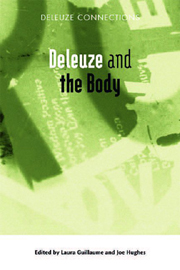Book contents
- Frontmatter
- Contents
- Introduction: Pity the Meat?: Deleuze and the Body
- DELEUZISM
- 1 Time and Autopoiesis: The Organism Has No Future
- 2 Larval Subjects, Autonomous Systems and E. Coli Chemotaxis
- 3 Bodies of Learning
- 4 Believing in the World: Toward an Ethics of Form
- 5 Matter as Simulacrum; Thought as Phantasm; Body as Event
- PRACTICAL DELEUZISM
- Notes on Contributors
- Index
3 - Bodies of Learning
from DELEUZISM
Published online by Cambridge University Press: 12 September 2012
- Frontmatter
- Contents
- Introduction: Pity the Meat?: Deleuze and the Body
- DELEUZISM
- 1 Time and Autopoiesis: The Organism Has No Future
- 2 Larval Subjects, Autonomous Systems and E. Coli Chemotaxis
- 3 Bodies of Learning
- 4 Believing in the World: Toward an Ethics of Form
- 5 Matter as Simulacrum; Thought as Phantasm; Body as Event
- PRACTICAL DELEUZISM
- Notes on Contributors
- Index
Summary
Swimming: in an interesting passage in Difference and Repetition (1994) Deleuze considers what is involved in learning to swim. The general point of this passage is that learning to swim should not be understood as simply the passive reception of knowledge from an expert. None of us, after all, would expect to be able to swim after taking some classes by the side of the pool. Rather, learning to swim is a process that requires the engagement of one's own body with a body of water. From the outset, we can say that there are at least two bodies involved. But in what sense do these bodies interact with each other in the process of learning? To understand this interaction we must first grasp that a person's body and a body of water, according to Deleuze, are composed of both universal and singular aspects. Each body has a universal aspect to the extent that it is constituted by a system of differential relations – relations of height, depth, limits and turbulences, for example – such that we can talk of how a human body embodies these relations as opposed to the manner in which these relations are embodied within a body of water. Deleuze refers to the system of differential relations that constitute bodies as the objective Idea of the body. None the less, every body (be it of a person or of water) is composed of particular variations within the system of relations that constitute the objective idea (as when we say, for example, that the shallow end stops here, for me, but not someone else).
- Type
- Chapter
- Information
- Deleuze and the Body , pp. 53 - 72Publisher: Edinburgh University PressPrint publication year: 2011



